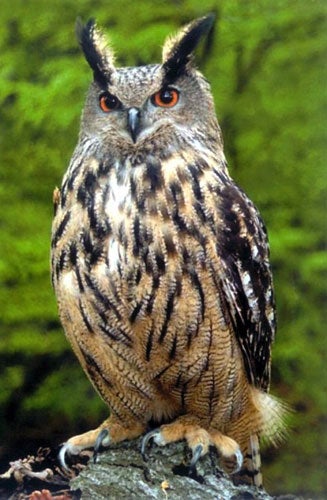Largest owls in the world threaten British birds

Your support helps us to tell the story
From reproductive rights to climate change to Big Tech, The Independent is on the ground when the story is developing. Whether it's investigating the financials of Elon Musk's pro-Trump PAC or producing our latest documentary, 'The A Word', which shines a light on the American women fighting for reproductive rights, we know how important it is to parse out the facts from the messaging.
At such a critical moment in US history, we need reporters on the ground. Your donation allows us to keep sending journalists to speak to both sides of the story.
The Independent is trusted by Americans across the entire political spectrum. And unlike many other quality news outlets, we choose not to lock Americans out of our reporting and analysis with paywalls. We believe quality journalism should be available to everyone, paid for by those who can afford it.
Your support makes all the difference.Several pairs of eagle owls, the largest owls in the world, are now breeding in the wild in Britain, according to a new study.
But it is unlikely they will ever be considered British birds as they escaped from a large pool of birds kept in captivity.
With its prominent ear tufts, 6ft wingspan and its ability to kill birds as large as herons and animals as big as roe deer, the eagle owl is one of the most remarkable birds in Europe, nesting from Spain in the south to Russia in the north, but has always been absent from Britain.
However, in the past 15 years, several pairs of the birds have begun to nest in different parts of England, according to a review of the eagle owl's status in Britain published in the journal British Birds.
Beginning with a nest found in the Derbyshire Peak District in 1993, there have also been successful or attempted nesting in North Yorkshire; in the Forest of Bowland in Lancashire; and at an undisclosed site in southern England.
The North Yorkshire pair raised 23 owls between 1997 and 2005. The Lancashire pair hit the headlines in May last year when they began attacking walkers, especially walkers with dogs, who took a footpath near their nest. This year, according to the British Birds study, the birds moved "to a less accessible site elsewhere in the Forest of Bowland ... laying three eggs and rearing three chicks".
However, the eagle owl is unlikely to be admitted to the official list of British birds which is maintained by the British Ornithologists Union (BOU), according to the study by Tim Melling, secretary of the BOU's records committee; Steve Dudley, its administrator; and Paul Doherty. This is because a review of all the historical evidence indicates that eagle owls have not bred naturally in Britain since the "land bridge" between Britain and the continent disappeared about 9,000 years ago when sea levels rose after the end of the last ice age – possibly because the birds do not like flying over extensive stretches of water.
Previous records of eagle owls found or shot in Britain in the past four centuries are now all thought to refer to captive-bred escapes, as the bird is very widely kept, especially for falconry. The study estimates there may be up to 3,000 eagle owls currently kept in captivity in Britain.
"The situation with the eagle owl in Britain is a difficult one," said Mark Avery, director of conservation for the Royal Society for the Protection of Birds (RSPB). "On the one hand, these are fantastic creatures. On the other hand, they are not British birds, and, as is the case with all introduced species, we do not know what impact they may have on our native fauna."
The eagle owl was a very different case from species such as the red kite or the white-tailed eagle, which have been successfully reintroduced to areas where they had previously bred, but had been persecuted to extinction, he said. "It's not that the eagle owl hasn't bred here for decades, or even centuries – it hasn't bred here for many thousands of years, so reintroducing it is simply not part of our conservation thinking," he added.
"One of the problems is that this bird is a top predator which can eat lots of things, and we do no know which parts of our native fauna it would pick on for its prey. So it would be better if people who own captive eagle owls did not let them escape, because we don't want any nasty surprises."
Nobody knows if the eagle owls breeding in Britain may be able to establish a self-sustaining population in the wild. It is thought unlikely – unless the population is boosted with further escapes from captivity or deliberate releases. Releasing a non-native species into the wild without authorisation is a criminal offence.
Size matters
*With its 6ft wingspan, and a body length of nearly 2ft 6in, the eagle owl is bigger than all other British birds of prey except for the golden eagle and the white-tailed eagle. It is twice the size of the tawny owl and the barn owl. The only other land bird to compare with it in size in Britain would probably be the great bustard, which died out nearly 200 years ago. To find a comparison one would have to look at water birds, such as the mute swan, the heron, or the crane.
Join our commenting forum
Join thought-provoking conversations, follow other Independent readers and see their replies
Comments